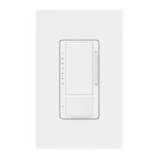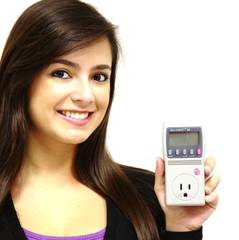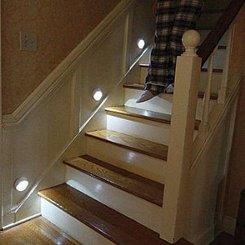 While occupancy sensor controls were originally created for use in commercial buildings, their role in residential buildings is becoming more commonplace. Many lighting companies have introduced automated lighting control product lines specifically for use in residential buildings and homes. These include occupancy sensor switches that have a sleek design that deliver proportional results to commercial counterparts, and cost much less. While these use the same technology as passive infrared occupancy sensors for commercial buildings, they do not need to be as powerful. The capacity of the controller does not need to detect occupancy by such an expansive measure because it is employed in rooms that have much lower ceilings and dramatically less square footage. In addition to the price tag, the design of these components also benefits as compared to commercial occupancy sensors. The actual module can pack the required technology in a smaller clamshell that easily fits in a traditional wall switch junction box. Manufacturers are also taking the initiative to offer decorative faceplates to match the décor in your home. One company that seems to be doing all of this better than others is Lutron.
 There are several reasons why occupancy sensor switches are a great upgrade to traditional light switches. They are convenient, energy efficient, and can save you money, to name a few. However, some homeowners find it difficult to justify the initial cost of an occupancy sensor by the continual savings on electricity in a reasonable amount of time. This is a valid concern for certain applications, and if the convenience isn’t worth paying for only one thing can help justify buying an occupancy sensor: a smaller price tag!
The Decora PR180-1LW by Leviton is an affordable residential occupancy sensor that packs the same technology as comparable higher end motion sensor switches. Just because it is less in cost does not mean it lacks in quality. This particular Leviton Decora occupancy sensor can be found for less than $16. When mounted in a standard wall switch junction box it detects motion using passive infrared technology. It’s field of view is a full 180 degrees along the wall it is mounted on and can see everything in front of it.
 A unique but practical way to cut back on energy consumption is to create an energy budget. While this may seem inconvenient it is effective and parallels many other methods of cutting back. We budget the way we spend money, we count calories, and manage our time the same way; so why not budget our energy consumption? Just as any of these other methods, a homeowner must first start with a plan, and then must acknowledge and commit to the plan everyday along with anyone else who lives in the home. This may seem restricting and inconvenient, but often people don't realize how much energy they waste every day without even knowing it. For the sake of simplicity, let’s focus this sample energy budget on electricity. Begin by assessing the amount of electricity consumed by larger electric appliances in your home. Examples would be refrigerators, microwaves, electric ovens, and heating and cooling units. This information is available on energy star labels that are provided with your appliances. If you do not have the information with your owner’s manual, try looking it up online at energysavers.gov. The information we are looking for is energy consumption in watts per year.
 There are many ways one can lower energy bills. The key is identifying where a home is most energy inefficient. This contributing factor could be one of many different deficiencies that are often relatable to a particular region's climate or how certain homes were built at a certain time. For example, older homes were built with very little or no insulation, making the contributing factor for high energy bills the building envelope. In older climates where heating systems are in demand for most of the year, well insulated windows walls and doors are often cost effective energy upgrades.
While heating and cooling loads drive up energy costs there are other common energy deficiencies that are often overlooked. A DIY home energy audit can help you determine what these are. While aspects of an energy audit relating to the building envelope are pretty straight forward, finding sources of inefficient lighting technology is a little less intuitive.
Controlling a low voltage lighting system with an occupancy sensor is an extravagant and energy efficient addition to a variety of low voltage lighting applications around your home. Low voltage lighting is becoming increasingly popular in DIY home projects and renovations because it is inexpensive, low maintenance, and easy to install. While it can be used in practical applications such as security lighting, under cabinet lighting or to illuminate trip hazards in a dark backyard patio, it is also used as accent lighting in bookshelves, cabinets, and gallery spaces.
In most cases, an occupancy sensor can be added to your low voltage lighting kit to supplement and further enhance the practical and aesthetic features in many ways. Often these lighting kits are installed and then frequently ignored because they are not essential lights for everyday activity. But if they are controlled by an occupancy sensor switch they will automatically turn on when the space is occupied and turn off when the area is vacant for a designated amount of time.
 There are many automated lighting systems on the market today. Each company that develops their own 'unique system' seeks to sell you not only their product but a lifetime obligation to their services. First, the system will have to be installed by one of their professionals and then you must pay to 'unlock' new features. All the while, the cost effectiveness of an automated lighting system seems to go out the door. So before you commit to a state of the art product and service, consider building your own automated lighting system with individual components. If well executed you can create a luxurious, convenient lighting system on the cheap that will provide energy savings for years to come.
First you must become familiar with what technology is out there. There several types of wireless communications, two in particular are most commonly used in lighting. The first is infrared technology. Infrared light is electromatic radiation that has a wavelength longer than visible light. These wavelengths are communicated by a corresponding frequency range. Each frequency communicated signals a different function or command to the end user lighting component. The other type of wireless communication is a wireless local area network (WLAN) or Wi-Fi. Each component within the automated lighting system will have an IP address on a network and transmit communications resulting in lighting controls and responses. The main benefit of Wi-Fi communications over infrared is that communications are relayed over the network and each component can send signals both forward and backward. Also all activities can be monitored by a base station on the network. This could be your home computer with Wi-Fi access or your smart phone. The base station logs onto the network and can monitor all signals being transmitted and even schedule activities. This is very helpful in creating an automated lighting system.
Now you can shop for lighting components that communicate on one of the two platforms and start to assemble a
unique one of a kind lighting system. One lighting component that is crucial to any lighting system is an occupancy sensor. While occupancy sensor switches are not ideal for all spaces and applications they can automatically turn lights off when not needed in areas of your home or office where you usually leave the lights on. This will help you save tons of money on your energy bills. Occupancy sensors are available to fit in a wall switch junction box or for a ceiling mounted application. There are
also a variety of lamps and LED fixtures that come fitted with occupancy sensors built-in. This option adds an extra dimension of flexibility to your DIY automated lighting system design; allowing you to place sensored lighting in areas where conduit had never been installed.
These are interesting times for those who enforce energy standards across the United States. Building codes and ordinances are similar to any other laws enforced by the judicial system in that they exist on several levels.There are international building codes, federal and state building codes, and even local building codes and ordinances. While each set of regulations has similar fundamental characteristics, one can see variance according to a particular region's energy initiatives. Energy efficiency initiatives are they driving force behind changes in building codes to become more stringent on energy consumption. While Germany, Denmark, and Switzerland remain some of the most energy efficient countries, the United States struggles to keep up. One state that is pushing energy efficient initiatives far more than others is California. The results are proven by a measure of per capita energy consumption. California's per capita energy consumption is 50% less than the average of all other states. One large contributing factor to California's energy efficiency achievements is the Title 24, Part 6 of the 2008 Building Energy Efficiency Standards. These standards meet and exceed federal Energy Star standards for many categories of building code requirements. One category that is strongly enforced in terms of energy efficiency is lighting, section 150(k).
There are many reasons to use occupancy sensors in your home or office. They can add convenience and luxury to any space at an affordable price. However the most popular reason to install occupancy sensor switches is to increase a building's energy efficiency and save the owner money. It is always cost effective to install occupancy sensors, but this guide will help determine the most cost effective automated lighting plan using occupancy sensors in your home or office. With the help from historical statistics from the EPA, the Energy Efficient Lighting Supply has identified the most cost effective spaces to install occupancy sensors. Click below to view the guide.  | cost_effective_use_of_occupancy_sensors.pdf | | File Size: | 309 kb | | File Type: | pdf |
Download File
Motion-activated path lights combine the technology of an occupancy sensor with high output, low consumption LED lights. Path lights can be hardwired with a low voltage power source or battery powered for flexible design and ease of installation. In each case, occupancy sensing or motion-activated path lights are convenient way to add useful lighting to a space while saving energy. Path lights are specifically designed to light up dark corridors or stairwells which rarely see natural light, even in the daytime. Rather than wiring extra light fixtures to light these areas and inconvenience with you with light switches which we tend to leave on when not needed, occupancy sensing pathlights will turn themselves on or off when needed and not needed. This is not only a luxury but also a safety feature to add to your home or backyard. Consider how many times you find yourself shuffling around in a dark hallway looking for a light switch. With motion-activating path lights there is no need to dangerously walk around un-lit stairwells anymore. Motion-activating path lights also add a modern and futuristic look that is sure to blend in with and spice up even the most conventional decor. Here are several examples of where you can use occupancy sensing path lights to add convenience, safety, and luxury to your living spaces. 1. Stairwell or Hallway- Of course, this is the most popular use for occupancy sensing pathlights. Path lights will turn on one by one as an occupant ascends or descends your dark hallway. This safety feature looks luxurious and is sure to add flare to an otherwise boring space. 2. Outdoor stairs- Outdoor pathways often include stairs to adjust elevation changes in the terrain. These stairs are often trip hazards in areas that are not always lit. Trust motion-activated path lights on each riser to detect an occupant when he or she is six feet away and light up the stairs. 3. Under Cabinet Lighting- Install motion activated path lights in your kitchen to light up shaded work spaces under your upper wall cabinets. This alternative to traditional LED under cabinet lighting can save even more energy and look even cooler as it lights up only the counter top space that you are using. 4. Gallery lighting- Add an extra dimension to the artwork in your home. As occupants walk by to observe hanging artwork a motion activated path light mounted over your painting or series of paintings is sure to draw them in and bring your artwork to life. 5. Closet spotlights- Closets in older homes and even some newer homes are rarely wired for lighting. And if they are, occupants are constantly leaving the closet light on! Never leave the closet light on again with occupancy sensing path lights over each section of clothing. This will make getting up and picking out your clothes fun and easier than ever.
An occupancy sensor is a small electronic component, about the size of a light switch, that can detect the presence or absence of occupants in a space, thus turning the lights they are controlling on or off. There are two main types of occupancy sensors; one uses passive infrared technology while the other uses ultrasonic technology. Passive Infrared sensors detect heat energy in a room. By sending an array of infrared lasers from its location in a room it can detect when one crosses the ‘line of sight’ of the sensor. These sensors are very appropriate for locations where traffic is unobstructed by objects, but also spaces that are not too open. According to the National Lighting Product Information Program, passive infrared occupancy sensors detected medium sized motion in an open space office area at 35% of the locations. This data does not reflect the effectiveness of passive infrared technology but rather the planning required to appropriately place these sensors based on the technology they use. In the same study, ultrasonic occupancy sensors were also tested. The results revealed that medium sized motion was detected at 98% of the locations. Ultrasonic occupancy sensors works similar to a submarine’s sonar technology. The ultrasonic sensor sends high frequency waves that return to the sensor after traveling across a space. Once irregularities of these patterns occur, the sensor is triggered. Once activated, the lights will turn on, and once the wave patterns return to a static state for a certain time the lights will turn off. Ultrasonic occupancy can be used in more locations than passive infrared occupancy sensors because the waves they send out can move around barriers while infrared lasers are calibrated to static position. Most ceiling mounted occupancy sensors use ultrasonic waves. Applying these occupancy sensors to an automated lighting setup in an open office area is very effective. The waves are capable if returning occupancy based information with in subdivided areas by partitions or a traditional cubicle setup. When integrating occupancy sensors into a cost effective automated lighting design, one should consider the usage of both types. While the ultrasonic is useful in more locations, it also ranges from 15%-33% more expensive than a passive infrared occupancy sensor. For this reason a cost efficient design will have passive infrared sensors where acceptable and ultrasonic sensors in other locations.
|






 RSS Feed
RSS Feed